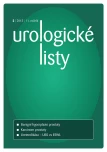Treatment and prophylaxis of recurrent lower urinary tract infections
Authors:
M. Fedorko
Published in:
Urol List 2013; 11(2): 33-37
Overview
Recurrent lower urinary tract infections (UTIs) are common in women, including healthy young women, and are associated with considerable morbidity and expense. In the era of increasing antimicrobial resistence, their management can be problematic. The article reviews different approaches to the prevention of reccurent UTIs, including behavioral modifications, probiotics, use of cranberries, immunoactive prophylaxis and antimicrobial prophylaxis. Summary of recommendation for everyday practice is provided.
Key words:
recurrent infections, lower urinary tract, prophylaxis
Sources
1. Foxman B. Recurring urinary tract infection: incidence and risk factors. Am J Public Health 1990; 80(3): 331–333.
2. Naber KG, Bergman B, Bishop MC et al. EAU guidelines for the management of urinary and male genital infections. Eur Urol 2001; 40(5): 576–588.
3. Hooton TM. Recurrent urinary tract infection in women. Int J Antimicrob Agents 2001; 17(4): 259–268.
4. Scholes D, Hooton TM, Roberts PL et al. Risk factors for recurrent urinary tract infection in young women. J Infect Dis 2000; 182(4): 1177–1182.
5. Hooton TM. Prevention of recurrent urogenital tract infections in adult women. In: Urogenital Infections. Arnhem: European Association of Urology 2010.
6. Raz R, Gennesin Y, Wasser J et al. Recurrent urinary tract infections in postmenopausal women. Clin Infect Dis 2000; 30(1): 152–156.
7. Grabe M, Bjerklund-Johansen TE, Botto H et al. Guidelines on Urological Infections. In EAU Guidelines, edition presented at the 28th EAU Annual Congress, Milan 2013.
8. Fowler JE, Pulaski ET. Excretory urography, cystography and cystoskopy in the evaluation of women with urinary tract infection: a prospective study. N Engl J Med 1981; 304(8): 462–465.
9. Perrota C, Aznar M, Mejia R et al. Oestrogens for preventiion of reccurent urinary tract infection in postmenopausal women. Cochrane Database Syst Rev 2008; (2): CD005131.
10. Botto H. Use of cranberry for prophylaxis of uncomplicated reccurent urinary tract infections. In: Urogenital Infections. Arnhem: European Association of Urology 2010.
11. Cadieux P, Reid G. Probiotics for the prophylaxis of uncomplicated recurrent urinary tract infections in females. In: Urogenital Infections. Arnhem: European Association of Urology 2010.
12. Stepanova M, Kruglikov V, Lebid L et al. Oral lactobacilli vs antibiotik prophylaxis for reccurent urinary tract infections in premenopausal women (poster). Presented at 29th EAU Annual Congress, Milan 2013.
13. Schmidhammer S, Ramoner R, Holtl L et al. An Escherichia coli-based oral vaccine against urinary tract infections potently activates human dendritic cells. Urology 2002; 60(3): 521–526.
14. Naber KG, Cho Y, Matsumoto T et al. Immunoactive prophylaxis of uncomplicated recurrent urinary tract infections. In: Urogenital Infections. Arnhem: European Association of Urology 2010.
15. Engeler D, Baranowski AP, Borovicka J et al. Guidelines on Chronic Pelvic Pain. In EAU Guidelines, edition presented at the 28th EAU Annual Congress, Milan 2013.
16. De Vita D, Antell H, Giordano S. Effectiveness of intravesical hyaluronic acid with or without chondroitin sulfate for recurrent bacterial cystitis in adult women: a meta-analysis. Int Urogynecol J 2013; 24(4): 545–552.
17. Lichtenberger P, Hooton TM. Antimicrobial prophylaxis in women with recurrent urinary tract infections. In: Urogenital Infections. Arnhem: European Association of Urology 2010.
18. Melekos MD et al. Post-intercourse versus daily ciprofloxacin prophylaxis for recurrent urinary tract infections in premenopausal women. J Urol 1997; 157(3): 935–939.
19. Schaeffer AJ, Stuppy BA. Efficacy and safety of self-start therapy in women with reccurent urinary tract infections. J Urol 1999; 161(1): 207–211.
Labels
Paediatric urologist UrologyArticle was published in
Urological Journal

2013 Issue 2
Most read in this issue
- Treatment and prophylaxis of recurrent lower urinary tract infections
- Pharmacotherapy in LUTS/BPH in everyday clinical practise. How to choose the optimal alternative?
- Shock wave lithotripsy versus ureteroscopy for ureteral calculi: A prospective assessment of patient-reported outcomes
- The current reality and future prospects of less invasive technology for the treatment of BPH
